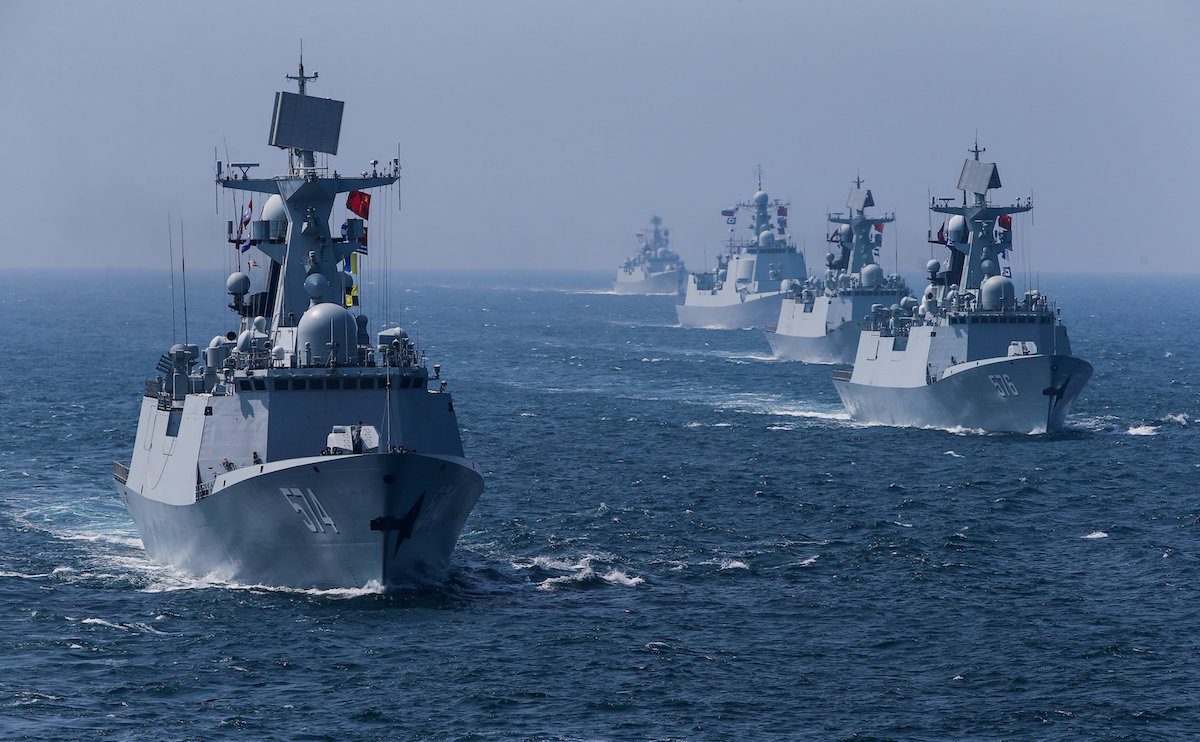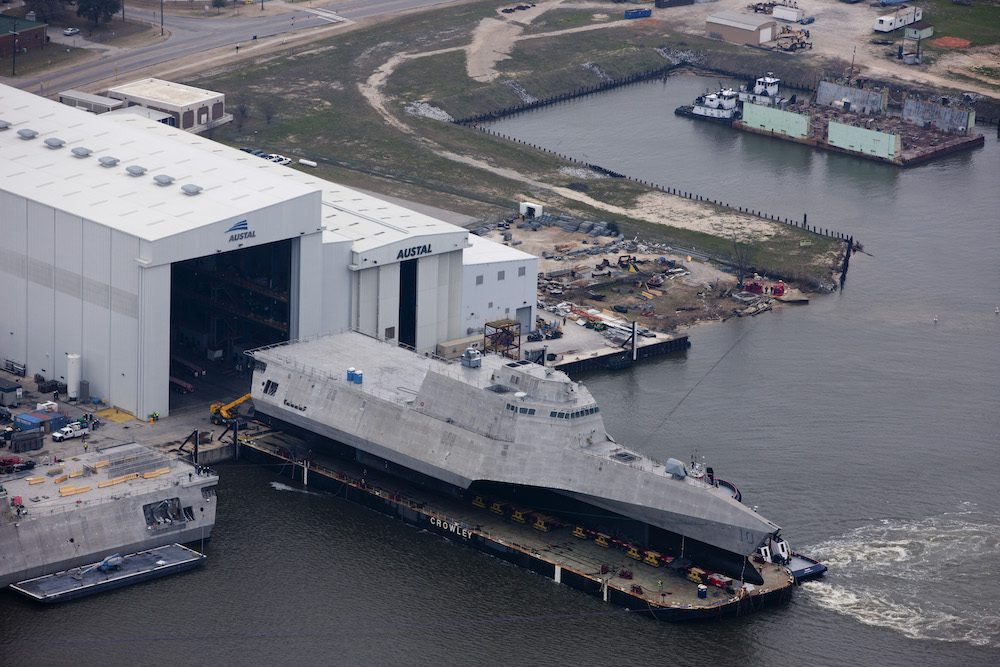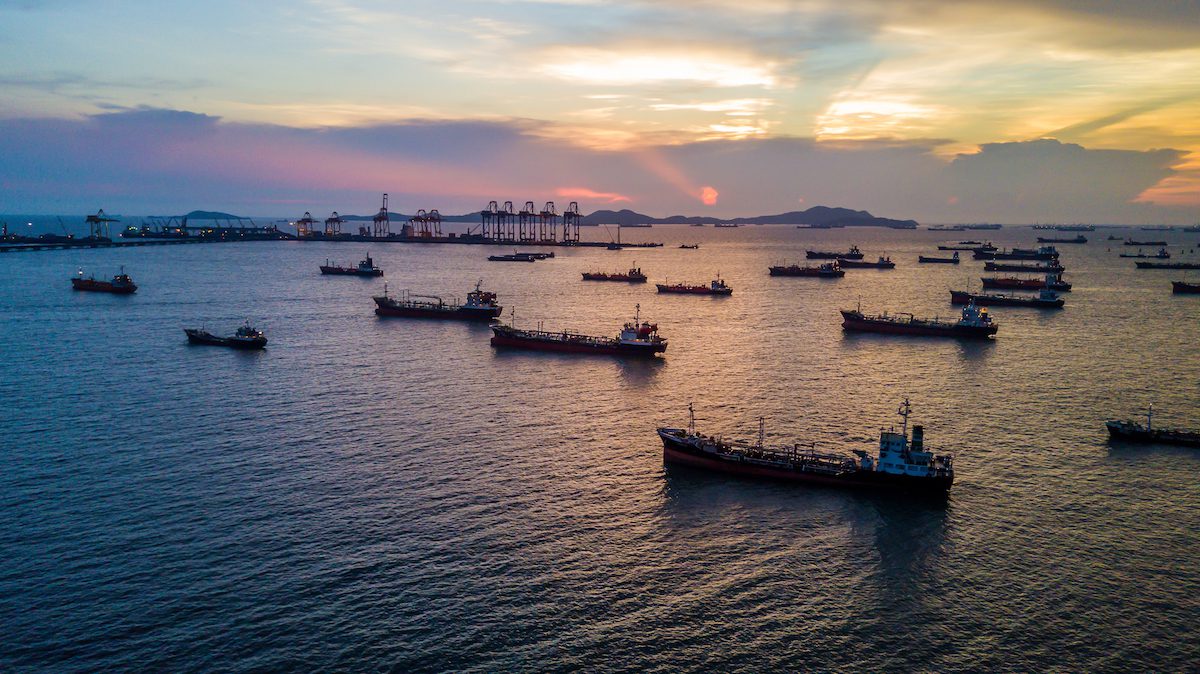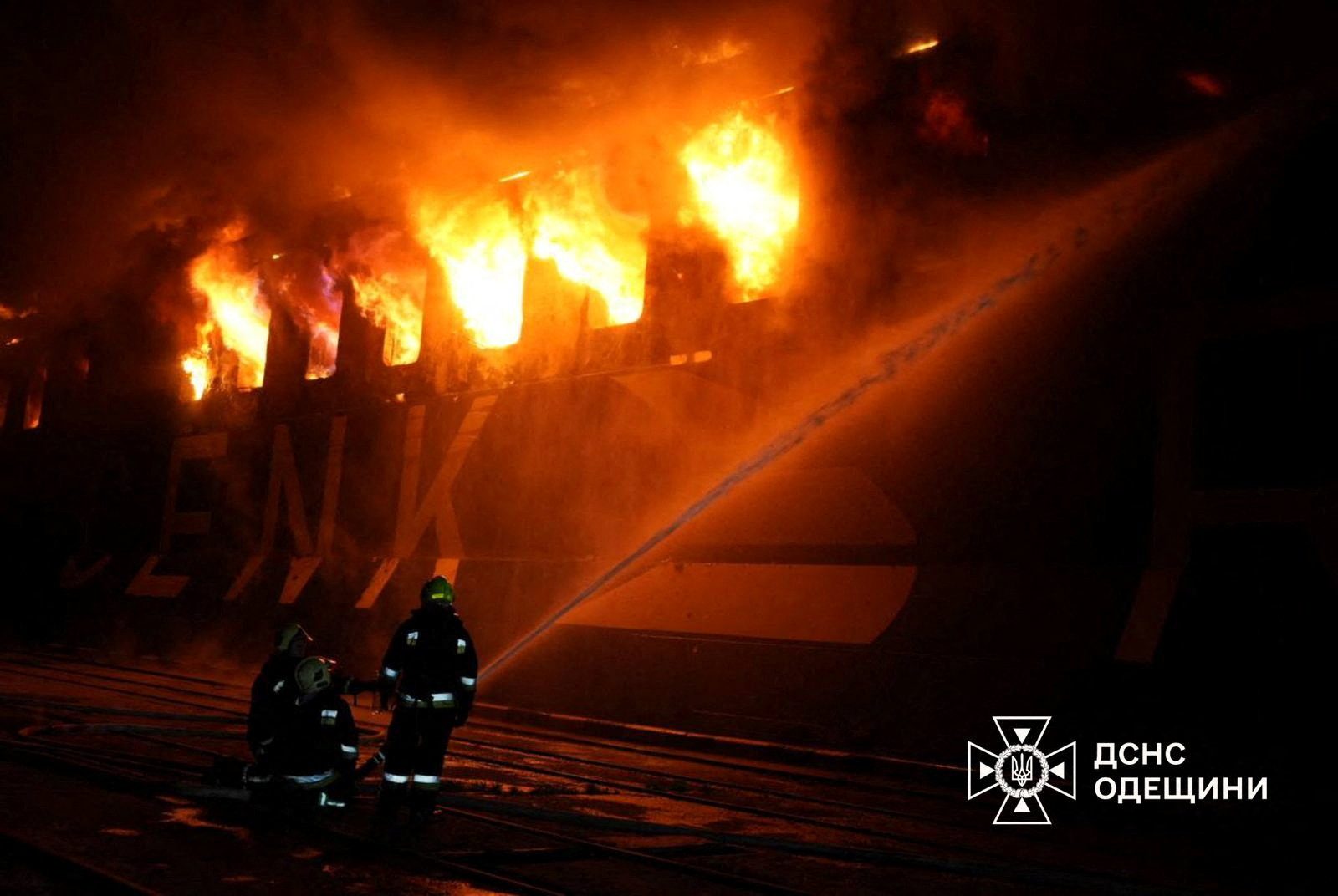FILE PHOTO – A fleet of ships sail out at sea as China and Russia’s naval joint drill concludes in Zhanjiang, Guangdong Province, China, September 19, 2016. REUTERS/Stringer/File Photo
 By David Lague and Benjamin Kang Lim TAIPEI, April 30 (Reuters) – A generation ago, from mid-1995 into early 1996, China lobbed missiles in the waters around Taiwan as the self-governing island prepared to hold its first fully democratic presidential election. Washington forcefully intervened to support its ally, sending two aircraft carrier battle groups to patrol nearby. The carriers, then as now the spearhead of American power, intimidated Beijing. The vote went ahead. The missiles stopped.
By David Lague and Benjamin Kang Lim TAIPEI, April 30 (Reuters) – A generation ago, from mid-1995 into early 1996, China lobbed missiles in the waters around Taiwan as the self-governing island prepared to hold its first fully democratic presidential election. Washington forcefully intervened to support its ally, sending two aircraft carrier battle groups to patrol nearby. The carriers, then as now the spearhead of American power, intimidated Beijing. The vote went ahead. The missiles stopped.
Today, with tension again running high, Washington still backs Taiwan. Chinese President Xi Jinping on January 2 renewed Beijing’s longstanding threat to use force if necessary to restore mainland control over the island. But the United States is now sending much more muted signals of support.
On Sunday, American ships sailed through the Taiwan Strait. This was the seventh passage of U.S. warships through the narrow, strategically sensitive waterway since July. Each time, though, just two U.S. vessels have ventured through; this week, it was a pair of destroyers. No powerful flotillas and certainly no aircraft carriers. It has been more than 11 years since an American carrier traversed the Taiwan Strait.
“The Trump administration faces a dilemma,” said Chang Ching, a retired Taiwan naval captain and researcher at the Taipei-based Society for Strategic Studies. “They want to send smart, calibrated signals to Beijing without causing an overreaction or misunderstanding.”
This caution is typical of the restraint the U.S. and allied navies, including Japan and Australia, now display in international waters near the Chinese coast, according to more than 10 current and former senior U.S. and Western military officials.
China now rules the waves in what it calls the San Hai, or “Three Seas”: the South China Sea, East China Sea and Yellow Sea. In these waters, the United States and its allies avoid provoking the Chinese navy.
In just over two decades, the People’s Liberation Army (PLA), the Chinese military, has mustered one of the mightiest navies in the world. This increased Chinese firepower at sea – complemented by a missile force that in some areas now outclasses America’s – has changed the game in the Pacific. The expanding naval force is central to President Xi Jinping’s bold bid to make China the preeminent military power in the region. In raw numbers, the PLA navy now has the world’s biggest fleet. It is also growing faster than any other major navy.
“We thought China would be a great pushover for way too long, and so we let them start the naval arms race while we dawdled,” said James Holmes, a professor at the U.S. Naval War College and a former U.S. Navy surface warfare officer.
China’s Ministry of National Defense, the U.S. Indo-Pacific Command and the Pentagon did not respond to questions from Reuters.
For the United States, the stakes are now much higher in any operation to support its regional allies, including Japan and Taiwan. America now faces daunting obstacles to any efforts to reinforce heavily outgunned Taiwan in a crisis. Beijing regards Taiwan as a renegade province and is currently building an amphibious force that could give it the capacity to launch an invasion of the island.
Senior Asian defense and security officials say the PLA’s naval advances have introduced a new uncertainty in such scenarios: If Beijing can sow serious doubt about whether Washington will intervene against China, it would undermine the value of U.S. security guarantees in Asia.
In November, a bipartisan commission set up by Congress to review the Trump administration’s national defense strategy reported that in a war with China over Taiwan, “Americans could face a decisive military defeat.”
RAPID EXPANSION
As China gains confidence that it can dominate its near seas, it intends to challenge the dominance of the U.S. Navy in distant waters, too, in the Western Pacific and Indian Ocean, according to U.S and Chinese military officials.
Satellite imagery of Chinese dockyards, reports in China’s state-controlled media and assessments of U.S. and other foreign naval experts show the PLA navy is expanding as fast as shipyards can weld hulls together. This emerging blue water fleet was just a dream for the early commanders of the communist navy born in 1949, during the closing stages of the nation’s civil war. Then, the People’s Liberation Army assembled a motley collection of conscripted fishing boats and vessels defecting from the Nationalists.
Since 2014, China has launched more warships, submarines, support ships and major amphibious vessels than the entire number of ships now serving in the United Kingdom’s fleet, according to an analysis from the London-based International Institute for Strategic Studies published in May last year. Between 2015 and 2017, China launched almost 400,000 tonnes of naval vessels, about twice the output of U.S. shipyards in that period, the IISS said.
The PLA navy now has about 400 warships and submarines, according to U.S. and other Western naval analysts. By 2030, the Chinese navy could have more than 530 warships and submarines, according to a projection in a 2016 U.S. Naval War College study.
A shrunken and overworked U.S. Navy, which has ruled the oceans virtually unchallenged since the end of the Cold War, had 288 warships and submarines at the end of March, according to the Pentagon.
Globally, the U.S. Navy remains the dominant maritime force, the power that keeps the peace and maintains freedom of navigation on the high seas. Chinese military and political figures say that while their nation’s fleet has more ships, America has more powerful ones, and overall supremacy at sea.
“The Chinese navy is at least three decades behind the United States,” a retired Chinese naval officer told Reuters, requesting anonymity. “It is too early for the United States to fret.”
China, however, has established dominance in the waters closest to its coast.
ENDING CHINA’S HUMILIATION
The regular, highly publicized launch of new warships is a powerful political weapon for Xi Jinping. For a domestic audience, modern aircraft carriers, destroyers and submarines are hard evidence that what Xi describes as the “Chinese dream,” his vision of a strong, rejuvenated nation, is becoming reality.
Almost immediately after taking power in late 2012, Xi began a series of high profile visits to naval bases and voyages at sea on sleek, new warships. In documentary footage and news reports, he is piped aboard to the salutes of immaculately turned out officers and crew. Underway, he peers into the distance from the bridge through bulky naval binoculars, climbs ladders between decks and shares meals with sailors.
Last spring, he watched a giant exercise in the South China Sea, where a flotilla of 48 warships assembled in formation. Half of these vessels had been commissioned since Xi took power, state-controlled media reported. The highlight was the launch of jet fighters from China’s first aircraft carrier: the 60,000-tonne Liaoning, a refurbished Soviet-era flat top that has served as a test bed for carrier operations. The Chinese navy has launched a second carrier as well, which is now in sea trials and expected to join the fleet this year, according to U.S. officials.
A key message in the official coverage of Xi’s voyages: A vigilant navy under his command will guard against a repeat of the century of humiliation that began with the First Opium War in 1839, and during which European colonial powers and Japanese invaders took cruel advantage of a vulnerable China.
Every Chinese school child learns that China’s suffering arose partly because of the lack of a modern navy. Infamously, in the final years of the Qing Dynasty, the Empress Dowager diverted funds earmarked for naval modernization to building a new Summer Palace. This contributed to China’s heavy defeat in the 1894-95 war with Japan, in which a rising Japanese navy smashed the Chinese fleet.
While Beijing’s repeated references to these past humiliations have propaganda value, invasion is now regarded as a highly unlikely threat, according to military strategy documents published by the Chinese government. Instead, China needs to prepare for high intensity conflict in its near seas, these documents say.
It is not spelled out exactly how these conflicts would arise. But officers from the U.S. and other foreign militaries say they have no doubt Beijing is referring to clashes over Taiwan or disputed territories in China’s near seas. This strategy is driving a shift away from Beijing’s traditional emphasis on land forces. It marks a historic transformation for an ancient continental power that for millenia feared armies encroaching overland from the north and west.
Xi has elevated the status of the navy within what is the world’s biggest military. In an unprecedented move for what has been an army-dominated force, a senior naval officer, Vice Admiral Yuan Yubai, was appointed in 2017 to head China’s Southern Theater Command, one of the country’s five regional commands.
Under Xi, the Communist Party has also opened the funding tap. Between 2015 and 2021, total military outlays are projected to jump 55 percent from $167.9 billion to $260.8 billion, according to a report last year that the U.S.-China Economic and Security Review Commission ordered from Jane’s By IHS Markit, a defense information company. Over the same period, the navy’s share of this budget is expected to increase 82 percent, from $31.4 billion to $57.1 billion, the report said.
The Chinese leader has set a clear direction for the navy to become a truly global force that would protect the country’s vast seaborne trade and expanding international interests. In its 2015 White Paper on defense, China said its navy would gradually shift its focus from defending its offshore waters to operations in the open seas.
For now, many of China’s warships are smaller vessels, including a big fleet of fast missile-attack craft. But Chinese shipyards are launching surface warships that are closing the gap in size, quality, and capability with the best of their foreign counterparts, according to interviews with veterans of the U.S., Taiwanese and Australian navies. China’s big fleet of conventional and nuclear submarines is also improving rapidly, they say.
By 2020, the PLA navy will boast more big surface warships and submarines than the Russian navy, the former head of the U.S. Pacific Command, Admiral Harry Harris, told a congressional committee last year. Some American naval experts believe China could achieve rough parity with the U.S. Navy in numbers and quality of major surface warships by 2030.
Crucially, the Chinese navy already has an edge in hitting power, according to senior officers from the U.S. and other regional navies. The best Chinese destroyers, frigates, fast attack craft and submarines are armed with anti-ship missiles that in most cases far outrange and outperform those on U.S. warships, these officers say.
A DIFFERENT WAR
This firepower explains why Washington keeps its carriers at a distance. The last U.S. carrier to pass through the Taiwan Strait was the now-decommissioned USS Kitty Hawk, which made a transit with its battle group in late 2007 after being denied a port visit to Hong Kong.
The U.S. Navy and other foreign navies still sail near the Chinese mainland. But they avoid overt shows of force that would increase the risk of clashes with modern Chinese warships and submarines. Retired U.S. Navy carrier-fleet officers say that in recent years the Pentagon has also avoided sending carriers to the Yellow Sea between the Korean Peninsula and the Chinese mainland, amid repeated Chinese warnings.
An example of China’s determination to control its near waters came this month, when a French warship passed through the Taiwan Strait. After the April 6 transit of the frigate Vendemiaire, China informed Paris that France was no longer welcome to attend celebrations last week to mark the 70th anniversary of the founding of the Chinese communist navy, U.S. officials told Reuters.
Veteran U.S. Navy officers predict any serious conflict with China off its coast would be bloody. The United States and its allies would risk heavy losses and possible defeat, they say.
This type of conflict would be vastly different from the wars the United States has been fighting in the Middle East and Afghanistan. There, America enjoyed unchallenged air and sea superiority and unimpeded logistics, said Gary Roughead, co-chairman of a 2018 review of the Trump administration’s defense strategy. Today, heavy damage to or losses of American warships or major bases is a real but underappreciated possibility for the United States in a conflict with China, said Roughead, the former Chief of Naval Operations, the top job in the U.S. Navy. “We have not thought about the significant capital losses that will occur – and the American people not being prepared for that,” he said in an interview with Reuters. “Those are significant factors in the win-loss equation.”
Chinese military veterans and people with ties to the ruling Communist Party leadership say China’s new naval muscle is defensive in nature. It is essential, they say, to counter a hostile United States that sees China as an enemy.
“Without air and sea domination, Chinese naval vessels will just be targets in the event of conflict,” said a retired PLA officer. “For Southeast Asian neighbors, China’s navy may be intimidating, but its prowess is limited to waters near the country’s shores and too early to be a force to be reckoned with in the open sea.”
The PLA navy is growing and improving, and in sheer numbers of vessels, exceeds its American rival. But China still falls well short of overall U.S. naval power. With 11 aircraft carriers, 88 powerful surface warships and 69 nuclear-powered submarines, America deploys the mightiest fleet and is likely to maintain a technological edge for some time, according to U.S. and Chinese military officials.
In response to the challenge from China and a resurgent Russian navy, the Pentagon is rebuilding its fleet and accelerating development of new weapons, including the urgent introduction of longer-range missiles. The United States aims to deploy a 355-strong fleet by 2034, according to the Trump administration’s 2020 budget proposal documents. And key U.S. allies Japan, South Korea and Australia are upgrading their navies with new, advanced warships and submarines.
China also faces challenges in its drive to become a global naval power. Chinese and foreign naval experts warn that Beijing faces a colossal funding burden as it adds multiple warships to its fleet. Typically, navies wind up paying the initial price of building a warship three times over its service life, if maintenance and refitting costs are included, according to shipbuilders.
In some vital naval technologies, China is struggling to catch up. Chinese shipyards still rely on foreign suppliers for some engines, weapons and sensors, according to global arms trade registers. High-profile arrests of suspected Chinese spies accused of stealing military secrets in the United States suggest China’s navy has shortcomings in radars, underwater sensors and other electronic technologies.
The PLA navy is well behind the U.S. and other navies in anti-submarine warfare, a serious deficiency, according to Chinese and Western military experts. Most Western military analysts also believe the Chinese navy lacks the amphibious capability to invade Taiwan – the vessels and skills to reach the island by sea and then put boots on the ground.
A VAST UNSINKABLE CARRIER
However, when it comes to dominating its near seas, China doesn’t need to match the U.S. ship-for-ship. The U.S. Navy is a globe-spanning force with offshore bases and multiple missions, including supporting Middle East operations, bolstering European allies, countering Russia’s naval revival and safeguarding global shipping routes. To do this job, the U.S. Navy has to dominate virtually all the world’s oceans.
In contrast, the entire Chinese fleet is based on the mainland coast. This means it has the advantage of being the home team. Without major global military responsibilities, the PLA navy can concentrate virtually all its forces in its coastal waters, flooding the zone inside what Beijing refers to as “the first island chain”: the arc that runs through the nearby major islands of the Japanese archipelago, Taiwan, the Philippines and Borneo.
In a conflict in these near seas, the Chinese mainland would function as a vast, unsinkable aircraft carrier. China’s warships would be close to logistical support and the firepower of land-based missiles and strike aircraft. These forces would seek to overwhelm enemy warships with volleys of missiles and torpedoes from multiple directions, U.S. and Chinese military analysts say.
Most of this firepower was unavailable to Beijing when President Bill Clinton deployed the two carrier battle groups off Taiwan in early 1996. China’s obsolete navy, geared for coastal defense, was powerless to respond, and Beijing could only watch helplessly as the Taiwanese vote went ahead.
This humiliation was a turning point, Chinese and Western navy officers say. Stung, China ordered from Russia two powerful destroyers armed with supersonic anti-ship missiles that could take out American carriers and other warships. Two more arrived later from a subsequent order.
Then China’s naval shipyards started cranking. Satellite imagery of the key yards at Shanghai, Dalian, Guangzhou and Wuhan show them almost continuously crowded with warships and submarines at different stages of construction. Since June 2017, Chinese shipyards have launched four heavily armed Type 055 cruisers, which U.S. and Chinese military officials say are a match for any modern warship.
Multiple warships can be seen under construction in one section of the Jiangnan Shipyard in Shanghai in April 2018, including Type 055 cruisers and Type 052D destroyers, advanced surface warships armed with long-range missiles for attacking naval and airborne targets. The first Type 055 cruiser, the 10,000-tonne Nanchang, has completed most of its sea trials and will soon join the fleet, the Chinese military said on April 25. It will deliver a major boost to China’s naval firepower when fully operational.
And the PLA is building a force of modern, amphibious heavy-lift vessels that in time could allow Beijing to mount a landing on Taiwan or disputed territories such as the Japanese-controlled Senkaku Islands, known as the Diaoyu Islands in China. The PLA is also training an expanded force of marines for amphibious landings. China’s marines are expected to be a 30,000-strong force by 2020, according to the Pentagon’s annual report on Chinese military power released in August.
On February 27, China’s second aircraft carrier put to sea from Dalian for its fifth round of sea trials, according to reports in the official media.
With the still-unnamed carrier now close to joining the fleet, the PLA navy celebrated its anniversary on April 23 with a multinational naval display off the North Sea Fleet headquarters at Qingdao. Xi Jinping was on hand as the Nanchang made its first public appearance with the fleet.
(Reporting by David Lague and Benjamin Kang Lim. Edited by Peter Hirschberg.)
(c) Copyright Thomson Reuters 2019.

 Join The Club
Join The Club











